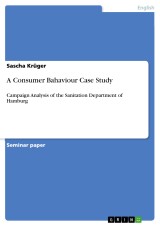Details

A Consumer Bahaviour Case Study
Campaign Analysis of the Sanitation Department of Hamburg1. Auflage
|
13,99 € |
|
| Verlag: | Grin Verlag |
| Format: | EPUB, PDF |
| Veröffentl.: | 21.04.2009 |
| ISBN/EAN: | 9783640313457 |
| Sprache: | englisch |
| Anzahl Seiten: | 20 |
Dieses eBook erhalten Sie ohne Kopierschutz.
Beschreibungen
Seminar paper from the year 2007 in the subject English Language and Literature Studies - Linguistics, grade: 1,7, University of Hamburg (Institut für Anglistik und Amerikanistik), course: The Role of Consumer Behaviour in Modern Marketing, language: English, abstract: More than 1.7 million people are living in Europe’s greenest city, the metropolis city of Hamburg, Germany. But there is no smoke without a fire. All of Hamburg’s inhabitants are consumers of a very important service provider: The Sanitation Department of Hamburg, SRH. A civilised cooperation would be unthinkable without the 2,500 men and women who dispose, on average, one million tons of waste annually. Disposal services are multi-million Euro businesses. In 2006, the total output averaged
approximately 350 million Euros. In other words, every Hamburg inhabitant paid directly by utility costs or indirectly by taxes, 206 Euros each.
These costs also include marketing and public relation expenses. At first glance, it is not clear why a public utility (for example, SRH) markets their products because it satisfies basic consumer needs than sophisticated wants. Furthermore, the SRH has a monopoly position. So, in fact, most of its marketing approaches have to be interpreted as community service
announcements.
In the second half of 2005, SRH started a campaign in cooperation with the advertisement agency, MKK Werbeagentur GmbH. The Campaign’s overall goal was to reach a wide effect utilising a low budget. The Campaign’s specific aim was to encourage a higher usage rate of the public wastebaskets which had a quite inconspicuous “working life” during the last decades. For example, prior wastebaskets were a “mouse grey” colour and
then after the Campaign, they were changed to a “fire red” colour. However, there was more changed than just the colours of the wastebaskets, they now also consisted of drawled eyes and naughty written slogans. The change is still taking place. There are still some wastebaskets which do not wear the new provocative outfit.
Hamburg has about 9,000 wastebaskets around the city. Thus, the new image requires an abundance of colour, creativity, and time.
This paper will analyse the Campaign through the perspective of consumer behaviour purposes. More specifically, it will examine the processes which are able to change consumer behaviour by utilising the key aspects of emotions, cognition, motivation, and attitude.
approximately 350 million Euros. In other words, every Hamburg inhabitant paid directly by utility costs or indirectly by taxes, 206 Euros each.
These costs also include marketing and public relation expenses. At first glance, it is not clear why a public utility (for example, SRH) markets their products because it satisfies basic consumer needs than sophisticated wants. Furthermore, the SRH has a monopoly position. So, in fact, most of its marketing approaches have to be interpreted as community service
announcements.
In the second half of 2005, SRH started a campaign in cooperation with the advertisement agency, MKK Werbeagentur GmbH. The Campaign’s overall goal was to reach a wide effect utilising a low budget. The Campaign’s specific aim was to encourage a higher usage rate of the public wastebaskets which had a quite inconspicuous “working life” during the last decades. For example, prior wastebaskets were a “mouse grey” colour and
then after the Campaign, they were changed to a “fire red” colour. However, there was more changed than just the colours of the wastebaskets, they now also consisted of drawled eyes and naughty written slogans. The change is still taking place. There are still some wastebaskets which do not wear the new provocative outfit.
Hamburg has about 9,000 wastebaskets around the city. Thus, the new image requires an abundance of colour, creativity, and time.
This paper will analyse the Campaign through the perspective of consumer behaviour purposes. More specifically, it will examine the processes which are able to change consumer behaviour by utilising the key aspects of emotions, cognition, motivation, and attitude.
Diese Produkte könnten Sie auch interessieren:

Politeness in Shakespeare: Applying Brown and Levinson´s politeness theory to Shakespeare's comedies

von: Abdelaziz Bouchara

43,00 €















